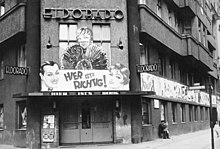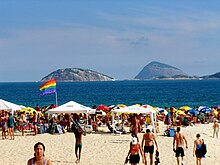Gay village
Much as other urbanized groups, some LGBT people have managed to utilize their spaces as a way to reflect their cultural values and serve the special needs of individuals in relation to society at large.Today, these neighborhoods can typically be found in the upper-class areas of a given city, like in Manhattan, chosen for aesthetic or historic value, no longer resulting from the sociopolitical ostracization and the constant threat of physical violence from homophobic individuals that originally motivated these communities to live together for their mutual safety.These neighborhoods are also often found in working-class parts of the city or in the neglected fringe of a downtown area – communities which may have been upscale historically but became economically depressed and socially disorganized.[4] This process does not always work out to the benefit of these communities, as they often see property values rise so high that they can no longer afford them, as high-rise condominiums are built and bars move out, or the only LGBT establishments that remain are those catering to a more upscale clientele.These neighborhoods, which often arise from crowded, highly dense, and often deteriorated inner city districts, are critical sites where members of gender and sexual minorities have traditionally congregated.The police raid of a private gay club called the Stonewall Inn on June 27, 1969, led to a series of minor disturbances in the neighborhood of the bar over the course of the subsequent three days and involving more than 1,000 people.This, along with several other similar incidents, precipitated the appearance of gay ghettos throughout North America, as spatial organization shifted from bars and street-cruising to specific neighborhoods.This transition "from the bars to the streets, from nightlife to daytime, from 'sexual deviance' to an alternative lifestyle" was the critical moment in the development of the gay community.The presence of gay men in the real estate industry of San Francisco was a major factor facilitating the urban renaissance of the city in the 1970s.Making these neighborhoods more desirable places to live, businesses and other classes of people move to the area and, accordingly, property values tend to go up.The urban studies theorist Richard Florida claims that their mere presence lures investors and jobs, particularly of the high-technology kind.[20] Famous gay residents currently include journalist Andrew Sullivan, filmmaker John Waters, and comedian Kate Clinton.[22] Boystown began with a cluster of bars on North Halsted Street and blossomed into an entire district dedicated to LGBT life and culture in the 1980s.According to the founders of Sidetrack, one of these pioneering bars, Boystown was only to grow as much as it did because its residents were politically engaged and actively resisted city efforts to drive them underground.Residents attribute this initial migration to a well-loved feminist bookstore called Women and Children First moving to Andersonville after being priced out of Boystown.[25] The Short North in downtown Columbus, Ohio, is primarily known as an art district, but has a strong gay community and a high concentration of gay-oriented clubs and bars.Having been priced out of owning or renting in the Hillcrest area, the San Diego LGBT community has spread outward for miles into North Park, University Heights and dozens more neighborhoods.Though some gay- and lesbian-oriented establishments can be found outside of this area, the general boundaries of this village have been defined by the Gay Toronto Tourism Guild.These establishments are mainly concentrated in the southwestern portion of the Marais, many on or near the streets Sainte-Croix de la Bretonnerie and Vieille du Temple.At the peak of its popularity, Boyztown drew in funding for AIDS-related charity organizations through grand events like the Pattaya Gay Festival.











<2%
2-2.9%
3-3.9%
4-9%

Philadelphia GayborhoodStonewall InnGreenwich VillageManhattana seriesLGBTQ topicsLesbianBisexualTransgenderSexual orientationgenderAromanticismAsexualityGray asexualityAcefluxDemisexualityFraysexualityBiologyBisexualityPansexualityDemographicsEnvironmentGender fluidityGender identityGender roleGender varianceHomosexualityIntersexNon-heterosexualNon-binary genderQueer heterosexualityQuestioningSexual identitySex–gender distinctionTrans manTrans womanTranssexualTwo-spiritHistoryTimelineSame-sex marriageMovementsGay liberationSame-sex unionsStonewall riotsGay menCultureBusinessComing outCommunityAfrican-AmericanDyke MarchEventsAwareness periodsLargest eventsNew queer cinemaPeriodicalsLGBTQ culturein New York CityPride MonthParadeQueer artQPR and QPPSame-sex relationshipPolariSocializationSubculturesSymbolsTakatāpuiMoe aikāneTourismRightsAdoptionCivil unionDecriminalizationGender self-identificationIntersex human rightsLegal recognition of non-binary genderMarriageMilitary serviceParentingRights by country or territoryRight to sexualityTransgender rightsYogyakarta PrinciplesHealthBlood donation restrictionsLGBTQ medical organizationsReproductionTransgender health careSuicideDetransitionSocial attitudes2020s anti-LGBTQ movement in the United StatesAllonormativityAmatonormativityCisnormativityHeteronormativityLGBTQ rights oppositionMixed-orientation marriageMedia portrayaltrans peopleSexual diversityStereotypesAcephobiaAIDS stigmaAnti-LGBTQ rhetoricGrooming conspiracy theoryBiphobiaBullyingCensorshipClosetedOutingComphetCriminalizationDomestic violenceErasureStraightwashingGay bashingGayphobiaHeteropatriarchyHeterosexismHomophobiaLiberalIntersex discriminationLegality of conversion therapy
